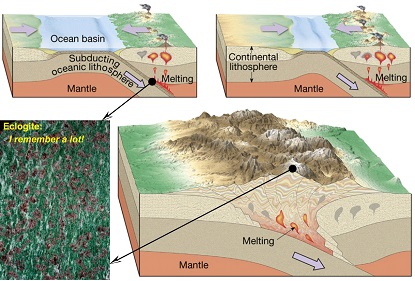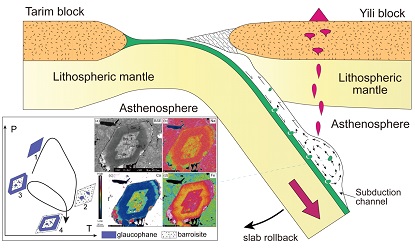Subduction zones are a vital element of plate tectonics. Where two tectonic plates meet, one bends and slides underneath the other and sinks into the mantle, therefore producing a subduction zone (Fig. 1). Subduction zones marks convergent boundaries of plates and play a key role in Earth’s geodynamics, crustal evolution, as well as earthquakes and volcanism (Fig. 1). When the oceanic crust is subducted to mantle depths (>60 km), the slab will undergo high-pressure metamorphism and release significant water through dehydration reactions transforming oceanic basalt to eclogite (Fig. 1). Under certain conditions, a small amount of eclogite rocks can be exhumed to the surface during subduction or plate collision processes. Therefore, scientists can investigate old subduction zones by studying the eclogites.
In recent work, Jilei Li and his colleagues from IGGCAS and Germany have deciphered a special process in subduction zone when they studied an eclogite sampled from the Chinese Tianshan high-pressure metamorphic belt. The eclogite underwent poly-cyclic metamorphism. Mineral chemical variations and textural discontinuities show that all the major phases of the rock (garnet, epidote, clinopyroxene and amphibole) display multiple growth zones. Spectacularly, mutually replaced glaucophane (high-pressure indicator) and barroisite (low-pressure indicator) indicate that the eclogite may have undergone a multistage burial-exhumation cycling (yo-yo-like subduction).
Further study of the P–T path derived from thermodynamic modeling suggests that the eclogite indeed experienced a complex metamorphic evolution with two P–T loops (Fig. 2). Therefore, it is suggested that the eclogite sample was first detached from the downgoing subducted oceanic crust, entered into the subduction channel, and then had a multistage burial-exhumation cycling with the convective flow in the subduction channel (Fig. 2).
As have been indicated in many previous numerical simulations, the “yo-yo-like movements” in the subduction channel at mantle depth now is confirmed in a natural setting by this study. This work provides valuable insights to understanding the processes in subduction zones.
This study was recently published in the Journal of Petrology (Li et al. Poly-cyclic metamorphic evolution of eclogite: evidence for multistage burial-exhumation cycling in a subduction channel. Journal of Petrology, 2016, 57: 119-146).

Fig. 1 Subduction zone and eclogite (photos from internet)

Fig. 2 Yo-yo-like movements in the subduction channel recorded by an eclogite with mutually glaucophane and barroisite replacements.
Contact:
LI Jilei
Division of Solid Mineral Resources, IGGCAS
E-mail: lijilei@mail.iggcas.ac.cn